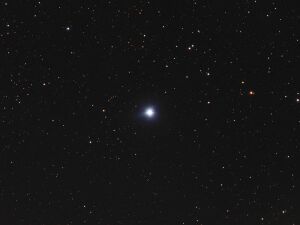Astronomy:50 Cassiopeiae
| Observation data Equinox J2000.0]] (ICRS) | |
|---|---|
| Constellation | Cassiopeia |
| Right ascension | 02h 03m 26.10206s[1] |
| Declination | +72° 25′ 16.6376″[1] |
| Apparent magnitude (V) | +3.95[2] |
| Characteristics | |
| Evolutionary stage | main sequence[3] |
| Spectral type | A2 V[3] |
| B−V color index | −0.002±0.007[2] |
| Astrometry | |
| Radial velocity (Rv) | −18.2±0.9[4] km/s |
| Proper motion (μ) | RA: −43.57[5] mas/yr Dec.: +22.30[5] mas/yr |
| Parallax (π) | 20.76 ± 0.14[5] mas |
| Distance | 157 ± 1 ly (48.2 ± 0.3 pc) |
| Absolute magnitude (MV) | 0.54[2] |
| Details | |
| Mass | 2.56±0.03[3] M☉ |
| Radius | 2.5[6] R☉ |
| Luminosity | 63.8+3.5 −6.4[3] L☉ |
| Temperature | 9,376+240 −235[3] K |
| Metallicity [Fe/H] | +0.18±0.28[7] dex |
| Rotational velocity (v sin i) | 91[3] km/s |
| Other designations | |
| Database references | |
| SIMBAD | data |
50 Cassiopeiae is a white star in the northern constellation of Cassiopeia. In the past, it had been misidentified as a suspected nebula, and given the number NGC 771.[9] The star is visible to the naked eye, having an apparent visual magnitude of +3.95.[2] Based upon an annual parallax shift of 20.76 mas, it is located 157 light years away. It is moving closer, having a heliocentric radial velocity of −18 km/s,[4] and will approach to within 82 ly in 1.879 million years.[2]
It is an A-type main-sequence star with a stellar classification of A2 V.[3] It is a suspected variable star with a very small amplitude.[11] 50 Cas has an estimated 2.56 times the mass of the Sun,[3] and about 2.5 times the Sun's radius.[6] It is radiating 64 times the Sun's luminosity from its photosphere at an effective temperature of around 9,376 K.[3]
The star was the brightest star in the occasionally used 1775 to 19th century constellation Custos Messium, typically drawn as a depiction of Charles Messier standing on top of the giraffe (Camelopardus), between Cepheus and Cassiopeia.[12]
References
- ↑ 1.0 1.1 Brown, A. G. A. (August 2018). "Gaia Data Release 2: Summary of the contents and survey properties". Astronomy & Astrophysics 616: A1. doi:10.1051/0004-6361/201833051. Bibcode: 2018A&A...616A...1G.
- ↑ 2.0 2.1 2.2 2.3 2.4 Anderson, E.; Francis, C (2012), "XHIP: An extended hipparcos compilation", Astronomy Letters 38 (5): 331, doi:10.1134/S1063773712050015, Bibcode: 2012AstL...38..331A.
- ↑ 3.0 3.1 3.2 3.3 3.4 3.5 3.6 3.7 3.8 Zorec, J.; Royer, F. (2012), "Rotational velocities of A-type stars. IV. Evolution of rotational velocities", Astronomy & Astrophysics 537: A120, doi:10.1051/0004-6361/201117691, Bibcode: 2012A&A...537A.120Z.
- ↑ 4.0 4.1 de Bruijne, J. H. J.; Eilers, A.-C. (October 2012), "Radial velocities for the HIPPARCOS-Gaia Hundred-Thousand-Proper-Motion project", Astronomy & Astrophysics 546: 14, doi:10.1051/0004-6361/201219219, A61, Bibcode: 2012A&A...546A..61D.
- ↑ 5.0 5.1 5.2 Van Leeuwen, F. (2007). "Validation of the new Hipparcos reduction". Astronomy and Astrophysics 474 (2): 653–664. doi:10.1051/0004-6361:20078357. Bibcode: 2007A&A...474..653V.
- ↑ 6.0 6.1 Pasinetti Fracassini, L. E. et al. (February 2001), "Catalogue of Apparent Diameters and Absolute Radii of Stars (CADARS) - Third edition - Comments and statistics", Astronomy and Astrophysics 367 (2): 521–524, doi:10.1051/0004-6361:20000451, Bibcode: 2001A&A...367..521P.
- ↑ Gáspár, András et al. (August 2016), "The Correlation between Metallicity and Debris Disk Mass", The Astrophysical Journal 826 (2): 14, doi:10.3847/0004-637X/826/2/171, 171, Bibcode: 2016ApJ...826..171G.
- ↑ "50 Cas". SIMBAD. Centre de données astronomiques de Strasbourg. http://simbad.u-strasbg.fr/simbad/sim-basic?Ident=50+Cas.
- ↑ Wolfgang Steinicke (19 August 2010). Observing and Cataloguing Nebulae and Star Clusters: From Herschel to Dreyer's New General Catalogue. Cambridge University Press. ISBN 978-1-139-49010-8. https://books.google.com/books?id=wyWjVWYWoO8C.
- ↑ MAST: Barbara A. Mikulski Archive for Space Telescopes, Space Telescope Science Institute, https://mast.stsci.edu/portal/Mashup/Clients/Mast/Portal.html, retrieved 8 December 2021.
- ↑ Koen, Chris; Eyer, Laurent (2002). "New periodic variables from the Hipparcos epoch photometry". Monthly Notices of the Royal Astronomical Society 331 (1): 45–59. doi:10.1046/j.1365-8711.2002.05150.x. Bibcode: 2002MNRAS.331...45K.
- ↑ Ian Ridpath's Star Tales - Custos Messium
External links
 |



